Compositional Applications for Binaural Beating in Timbre Modulation
While binaural beating is most commonly employed in spatial music and brain entrainment routines, the true potential of this psychoacoustic phenomenon within more traditional methods of electronic composition is often overlooked. A number of sizeable foundation studies have provided an understanding of binaural beating in relation to its scientific nature; however, significantly less is known regarding its application within timbre modulation in music. Timbre modulation can be explored through a combination of varying localization cues alongside spectral components including bandwidth, formant regions, periodic frequency content and phase properties. One of the primary elements of the perception of harmonic and inharmonic material is bandwidth phenomena, which also plays a key role in the perception and creation of binaural beating. By considering these factors, it appears that a direct link can be made between timbre modulation and binaural beating.
Some research exists that explores the relation between monaural beating and Western concepts of consonance and dissonance within composition, however, there is little published material written by composers that directly addresses the application of binaural beating in electroacoustic composition. Consequently, relatively little is known in relation to the finite behaviour (thus, the full potential) of binaural beating within composition and its potential for altering the listener’s perception of timbre.
Monaural Beating
When working with the psychoacoustic phenomenon of binaural beats, it is crucial that the practitioner has an understanding of the fundamental workings of monaural beats, as it can often offer solutions to factors relating to practicalities in performance. Monaural beating is a physical phenomenon concerning the combination of two static signals to form a single beating frequency. Brian Moore states that the resulting — i.e. sounding — frequency is the mean frequency of the two input tones (Moore 2012, 12), and, further, that the rate of the beat will be equivalent to the mathematical difference in Hertz between the two input tones and will fluctuate in amplitude from maximum to minimum intensity at that rate (Fig. 1; Audio 1).
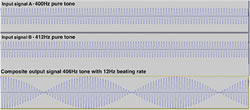
It is important to note that for pure monaural beats, the amplitude of the two input signals must be equal, otherwise the resulting amplitude of the instantaneous algebraic sum will always be a positive number, and therefore the amplitude modulation of the composite tone would never reach a pressure level of zero (Oster 1973, 96). While monaural beating is not a psychoacoustic phenomenon, at least some level of monaural beating should be expected when working with binaural beats unless headphone listening with hard panning is employed. To avoid monaural beating occurring at the output stage of loudspeaker or headphone performance, it must be understood that if frequency components are within approximately 30 Hz of one another (this can vary significantly due to factors relating to frequency and amplitude) and are not entirely separated in the loudspeaker arrangement (i.e. they are not hard-panned), then monaural beating is very likely to be an element of the resulting output content. Should a composer wish to avoid such effects, then a knowledge of all primary frequency components (including overtones for periodic content), and their loudspeaker positioning at all times, is necessary in ensuring that problematic frequencies are never distributed along the same channels simultaneously at any given time.
Binaural Beating
Whereas monaural beating is the result of acoustic phenomena, binaural beating occurs in the psychoacoustic realm — it is a direct consequence of a non-linear processing mechanism between the auditory nerve and the brain. While it is a very complex neurological phenomenon, Oster has simplified it by stating that:
The simplest explanation is that the number of nerve impulses from each ear and the route they travel to the brain are determined by the frequency of the incident sound, and that the two nerve signals interact somewhere in the brain. (Oster 1973, 98)
As designated zones along the basilar membrane resonate in response to particular frequencies, the subsequent disturbance of hair cells causes the firing of neurons along the auditory cortex towards the brain.
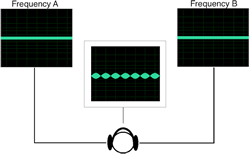
In the simplest terms, binaural beating can be explained as follows: when two frequencies are below (approximately) 15 Hz apart, and are presented dichotically through headphones (Fig. 2; Audio 2), the listener will perceive a composite tone that beats at a rate of the mathematical difference between the two frequencies per second (Oster 1973, 94).
Binaural beating is most effective when both frequencies are below 1000 Hz and is particularly prominent when they are at approximately 440 Hz (Ibid., 95). As the two frequencies move further away from each other, the beating will become less noticeable and a “roughness” in the sound is perceived. It should also be noted that a lower intensity binaural beat may be experienced when the beat stimuli are set “almost” an octave apart. For example, 200 Hz in the left ear and 398 Hz in the right ear will provoke a 2 Hz beat (Audio 3), with the beats having a lower amplitude than they would if both frequencies were within close proximity of each other (ca. 15 Hz).
The primary perceptual difference between monaural and binaural beating concerns the fluctuation in amplitude, which Oster explains as follows:
Monaural beats… pulse from loudness to silence, as their wave form would suggest. Binaural beats, on the other hand, are only a slight modulation of a loud background. I have tried to estimate the depth of the modulation, and it seems to be about three decibels. (Oster 1973, 97)
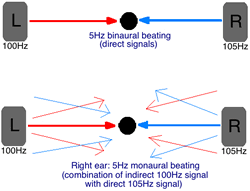
Monaural beats will naturally be caused as a secondary product due to reflections within the listening space. For example, a frequency of 100 Hz emitted from a loudspeaker positioned to the left of the listener and a 105 Hz frequency coming simultaneously from a loudspeaker to the right of the listener will cause a 5 Hz binaural beat. However, reflections of both signals will most likely be a factor in a typical performance environment, which will result in the listener’s ears receiving both the direct signal from one loudspeaker and the reflected signal of another in the same ear simultaneously, which can result in monaural beating (Fig. 3).
Existing Research Output
In relation to applications of binaural beating within music composition, to date there is very little published material directly proposing methods for its employment. The discussion in relation to uncovering finite data regarding the perceived amplitude modulation and exact active range of binaural beating (which differs for each individual) remains ongoing. While studies are commonly conducted into various binaural phenomena, those which investigate binaural beating are much less common; consequently, a significant lack of output exists within research concerning compositional methodology. In the 1970s, a relatively sizeable amount of research was conducted on binaural beats; however, other than discussions regarding the fundamental theoretical components of the phenomenon — which were outlined by Oster — very little progress has since been made in the area that could be beneficial to composers. John Grose, Emily Buss and William Hall described such findings as were available around 1970 as “scattered observations” and considered them to be “sparse and oddly disjointed” (Grose, Buss and Hall III 2012, 40). Creative methods concerning the interplay of the beating composite tone and primary tone parameters, estimated perceptual responses to differing amplitude levels between primary tones, and binaural beats triggered from complex inharmonic sound sources remain almost untouched and could prove to be a major benefit to the application of the phenomenon within music composition.
In addition to Oster’s material, research output in the 1970s also included Jerry V. Tobias’ “Curious Binaural Phenomena,” which considered varying perceptual sensitivities between men and women. David R. Perrott and Alan D. Musicant’s paper “Rotating Tones and Binaural Beats” claimed that the upper limit of binaural beat perception could stretch as high as 1170–1255 Hz (Perrott and Musicant 1977, 1288). Dennis McFadden and Edward Pasanen’s “Binaural Beats at High Frequencies” argued that binaural beats could be produced with acoustic primary tones (APT) of 3100/3101 Hz. The problem with their theory was that, as stated by the authors themselves, while the aforementioned frequencies were to be presented dichotically to the listener, a tone of 3000 Hz must also be presented to both ears (McFadden and Pasanen 1975, 394). Eric Heller’s book Why You Hear What You Hear disproves any beating that the listener perceives through this method by explaining the nature of monaural waveform beats (Heller 2013, 484–488). More recent research from Grose, Emily and Hall, notably in their paper “Binaural Beat Salience,” made some progress in relation to amplitude modulation (AM) behaviour within binaural beats. This method sought to match listener’s responses to sinusoidal amplitude-modulated tones to their perception of AM within binaural beats (Grose, Buss and Hall 2012, 40). The resulting data found that perception of AM shifts in binaural beating is quite weak (in the range of 400–500 Hz where beating is at its strongest) and, while the finer details of these findings are presented in this research, they would not prove beneficial to composers (Ibid., 45). As a result of these factors relating to a staggered output and lack of clarification within this area of research, many composers are aware of binaural beats but have only a scant amount of research that can be referred to when investigating the area, and so the potential applications and even the validity of binaural beating is largely overlooked in musical composition.
Intracranial Motion
While headphones could be seen as the ideal listening environment for such application procedures, multi-channel loudspeaker arrangements are quite effective in demonstrating this phenomenon within a compositional paradigm. The nature of intracranial motion is somewhat peculiar to binaural beat perception. Intracranial motion relates to the perceived movement of a binaural beat within one’s own head, and its theory is quite simple. The listener will often perceive a movement of the binaural beat as though it is travelling through their head at a rate of the binaural beat frequency. This phenomenon offers the composer a heightened sense of movement which is listener-specific, and the movement need not be generated explicitly by the composer in the loudspeaker setup through panning, etc. Michael Akeroyd’s brief document, entitled “A Binaural Beat Constructed from a Noise,” addressed noise-based stimulus for binaural beating by considering bands of noise presented dichotically to the listener with the phase and amplitudes of the components all modulated by a set frequency in one ear. Akeroyd found that, while such a method resulted in a stronger “percept of motion”, the data collected from the test subjects varied in relation to the behaviour of this movement (Akeroyd 2010, 3301–3304). This would suggest that, while intracranial motion can prove effective, a less specific treatment of this perception of movement should be considered within music composition.
Widening the Listener’s Sense of Space
Binaural beats can also be seen as a device which can add a greater sense of physical place within, in particular, a multi-channel loudspeaker arrangement. Certain tones will be perceived as being created within the listener’s own head, while the sounds emitted from the loudspeakers are perhaps perceptually travelling in many directions within the listening space. When considering a sense of space within a work, it is important to note how a perception of physical space can be created within such a context. A sizeable perceptual space does not need a large level of stimuli to be created. When positioned accordingly, two basic sonic elements are sufficient in creating a significant sense of space both in relation to pitch height as well as dimensional depth. The generation of binaural beating can be achieved with just two pure tones, which are closely positioned in terms of frequency and set in opposition to each other in a loudspeaker or headphone environment. This simple gesture will automatically generate a third sonic event that the listener can perceive within her own head while also perceiving tones that are produced by the loudspeakers and as a result of intracranial motion. Were the two tones in question not close in frequency, and therefore did not provoke binaural beating, the listener would experience a reduced sense of space in relation to how they perceive their own proximity to these loudspeaker tones. Alex Chechile applies similar thinking in his work with distortion product otoacoustic emissions (DPOAE) in composition. He writes:
In addition to loudspeaker-based sound diffusion, a second layer of spatial depth is created by provoking the ears to emit frequencies of their own. (Chechile 2015, 51)
Much like its monaural equivalent, binaural beating techniques can also be an efficient tool for timbre modulation as research into sensory dissonance directly relates to levels of beating and roughness. Stefan Koelsch has explained that:
When the beats have higher frequencies (above ~20 Hz), these beats are perceived as roughness… and are a sensory basis for the so-called sensory dissonance. (Koelsch 2013, 10)
Bandwidth Considerations
One of the primary elements of the perception of harmonic and inharmonic material is bandwidth phenomena, which also plays a key role in the perception and creation of binaural beating. By considering these factors it appears that a direct link can be made between timbre modulation and binaural beating. In relation to periodic material presented by acoustic instruments, the addition of electronics to a work can allow for manipulation of overtones. This can generate an effective shift in timbre and intracranial motion, as well as a widening of the perceptual listening space. For example, if a cello is playing a sustained A3 (220 Hz) its first two harmonics will sound at 440 Hz and 660 Hz. Digital signal processing can be used to selectively filter and control the recorded signal in order to assign one or more of the partials to one stereophonic position. Then, by pitch-shifting the 440 Hz and 660 Hz up or down by 5 Hz and directing these digitally manipulated frequencies to the opposite stereo position, a 5 Hz binaural beat will be generated within the harmonic series of the A3 note. If such an effect were to be presented monophonically (and monaural beating was evident), the behaviour of the beating and character of the dissonance would be entirely different, as intracranial motion would not be a factor. It would also display a smaller perceptual space that would not be the case if this method was conducted through binaural treatment. This method can also be applied to complex inharmonic structures, providing the use of notch filters (or similar) are applied to create stimulus tones. Inharmonic applications of binaural beats can prove to be very effective when considering spatial positioning and perceived movement within the listening space, particularly when considering thick, complex sonic materials.
Aspects Peculiar to the Phenomenon
Utilizing the audience’s inner ears within the performance potentially adds an entirely new dimension to the listening experience. Sonic materials created by binaural beating can be entirely positioned within the listener’s own head and thus can remain and be controlled independent of the loudspeaker or headphone output. This creation of a uterine environment through inner ear manipulation also allows the listeners to physically explore a listening space: by turning one’s head within a multi-channel environment, listeners themselves can modulate the timbre or even explore and experience varying levels of beating, if moving through the listening space is possible. This approach to composition also offers a greater opportunity for the listeners to obtain a heightened awareness of their own ears and their potential within musical performance.
The question of being able to replicate the sonic product that is created by the inner ear through external means often arises from a fundamental misinterpretation or misunderstanding of the ear-as-instrument concept. Binaural beats allow for sounds to perceptually travel within one’s own head. Aside from facilitating the production of sounds that may be otherwise impossible, it is the case that inner ear phenomena may also be responsible for the creation of material which could be seen to be somewhat replicated synthetically. In certain circumstances the fundamental sonic presentation of binaural beats can be easily synthesized through specific AM procedures carried out using sine waves; however, the nature of intracranial motion cannot be replicated using synthesis and loudspeakers — it is solely a psychoacoustic phenomenon.
Performance Considerations
A number of factors relating to varying performance spaces should be explicitly acknowledged and addressed when presenting work with a psychoacoustic focus. The most effective venues for the performance of material that has a heavy use of sinusoidal materials are those in which minimal reflections are present in the acoustic design of the space and a sound desk is well positioned in the path of all loudspeaker outputs. Works that include a significant use of sine tones as provocative agents in the employment of binaural beats will be less effective in acoustic environments in which a prominent level of reflections results in the Franssen effect becoming apparent in the space. 1[1. The Franssen effect is a psychoacoustic illusion which demonstrates “the inability of a listener to accurately localize a steady-state sine tone in a reverberant space” (Bates 2006, 184). This effect also reveals the place of spatial perception in the hearing process. Gary Kendall has outlined that the Franssen effect “demonstrates that listeners must be mentally constructing and updating some form of spatial representation in which events have spatial persistence” (Kendall 2010, 231).]
Depending on the level of intrusion in a work, the Franssen effect can often result in the composer’s spatial positioning of the pure tones being quite unidentifiable, or even rendered useless, at times. This acoustic phenomenon can impact upon works in which binaural beats are a primary compositional tool, as they can enhance monaural effects and will reduce the listener’s awareness of the positioning of the primary tones. Reflective environments will also increase the likeliness of spill from the loudspeaker environment into microphones that may be positioned close to instruments but outside of the loudspeaker arrangement. Should the microphone input contain any material that is present in the loudspeaker outputs, there is a sizeable risk of monaural beating becoming a factor in the loudspeakers that are outputting the microphone signal. For example, imagine that loudspeakers A and B are each presenting a single primary tone set 5 Hz apart (to provoke binaural beating) while also both containing the microphone signal of a live acoustic instrument. If the microphone is positioned in close proximity to loudspeaker A then it is likely that its signal will also be sent to loudspeaker B through the microphone channel, and so forth.
While fixed electronic components within a work provide a reliable delivery of a large proportion of the sonic material to the listener’s ears, live instrumental performers are not without a level of uncertainty that can be used to the composer’s advantage within works considering bandwidth phenomena. Even the slightest variation in the intonation of an acoustic instrument can enhance auditory beating effects, particularly when performing notes in the lower frequency regions, below approximately C4 (261.626 Hz). As the frequency distance between any two adjacent notes (a semitone apart) below C4 is less than 15 Hz, a slight mistuning can result in very effective beating effects, if accounted for within the compositional process. These effects can be — and of course have long been — explored as integral components in a composition. 2[2. For example, the D-flat (Db3) dyad played on the open (scordatura) second and stopped third strings in Lachenmann’s Pression (1969), where the solo cellist plays microtonal variations on the stopped note to “produce beating.”] For example, several musicians can be assigned the same pitches and dynamics but each may have different timings or instructions for playing microtonal variations on the given pitches. Should the score additionally offer an element of creative licence to the performer (such as the movement between two pitches or dynamics over a prolonged period of time), the effect can potentially be heightened further by the musicians in the course of the performance.
A number of factors come quite obviously into play here regarding the predictability of the phenomena we are presently concerned with, notably the variability of acoustic characteristics in individual performance spaces. The manipulation of the inner ear is a very delicate and intimate operation, and may well require a much greater degree of control for the phenomena to actually work and be perceived properly than some circumstances might afford. Therefore, in the case of stereo fixed media composition it could be argued that, in many respects, headphones are the ideal platform on which material performing the inner ear can be presented. Issues relating to room acoustics are virtually absent (or, at the very least, easily managed) and, providing the positioning and movement of the listener within the listening space, or the physical spatial positioning are not factors in the work, composing for headphone performance might seem ideal. If binaural beating is employed in the work, headphone listening will ensure the optimum presentation of the acoustic primary tones, thus maximizing the desired effects during the performance. Certain practical considerations could also possibly hinder headphone performances, such as programming considerations for concert halls, which will often prove inaccessible for such works due to the greater level of technology and setup required for simultaneous headphone performance to a large audience. 3[3. In fact large concert halls might even be “inappropriate” given that an acoustic space is not always needed for the performance of such works.] Furthermore, headphone compositions are very accessible to event programming when proposed as a listening station installation.
Discussions on the Author’s Own Compositional Material
The aforementioned aspects of binaural beat behaviour have been a source of compositional techniques in my work for quite some time. An outline of such material is provided here with respect to a number of electroacoustic works in a variety of instrumental contexts.
Waves (2016)
Waves is a stereo work for violin, cello and fixed media in which binaural beating is employed to explore tonality, with the electronics and strings in a constant battle to alter the tonality perceived by the listener. The roughness that is created by the binaural beating is a key feature of this composition, and places many of the sonic events physically within the listener’s own head, while also successfully achieving sensory dissonances at key moments through techniques relating to binaural and monaural beating.
A primary compositional technique in the opening section of this work considers the binaural beats caused from the crossing over of the violin and cello parts, which play glissandi in contrary motion throughout this section (Audio 1). While the fundamental frequencies performed by the strings are constantly modulating in the electronic part, static sine waves are placed at certain crossover points of the strings. The continuous flow between smoothness, roughness and beating, combined with the introduction and decaying of intracranial motion in this section, create a significant sense of tension through the push-and-pull nature of the perceived sonic material.
Furthermore, the bowing patterns of the two performers (at their own discretion) also adds to this sense of tension and release here. The constant fluctuation between harmonicity, dissonance and prominent beating is presented with varying rates of amplitude modulation, which cause a regular shift in timbral colour. While the tempo of these beats (cycles per second) naturally vary in this context, as the sliding violin and cello lines come into proximity with the static sine waves, the overall intensity of this timbral effect will vary between registral ranges: the higher the frequencies, the less the overall intensity of this effect, and so forth.
Swarm (2016)
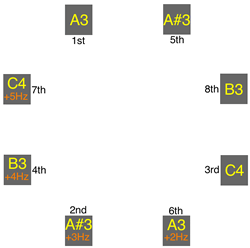
During the second section of this fixed-media octophonic piece, a complex array of manipulated oud samples creates a thick layer of binaural beat frequencies, all of which beat at a close but different rate. Each acoustic primary tone pair (APT) consists of the same sample with one tone in each pair pitch-shifted up by a set frequency value. As the APTs gradually enter in different loudspeaker positions around the listener (never entering in pairs or in succession), the build-up of this thick layer of beats is somewhat delicate (Fig. 4). In contrast to the delicate nature of the introductions of the stimuli, the turbulent sound world that results from such a procedure has various layers of sinusoidal-like pulsations (the composite frequency value of each APT pair) perceptually moving through the listener.
The listener will experience a slow build-up of sonic movement, which will appear to travel through them (as binaural beats are only generated in one’s head) as the APTs enter from various positions around the listening space. As the frequency differences between these APTs varies depending on which loudspeakers are presenting their material simultaneously, varying rates of binaural beating are experienced by the listener, while the direction of the intracranial motion will continue to shift in direction as the various APTs both enter and fade away.
Occultum Tabulatum (2015)
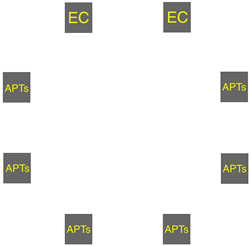
Occultum Tabulatum is an octophonic work for electric cello and fixed media that involves a very simple breakdown of the loudspeaker setup (Fig. 5). The intention was to explore the creative potential of residue pitch and auditory beating. Here, the listener’s ears perform the primary drone material over the duration of the piece, as the mathematical difference between each of the sine waves is 32.205 Hz (Fig. 6). This frequency is heard constantly by the listener throughout the work as a very low drone (residue pitch), without it ever being emitted through the loudspeakers.
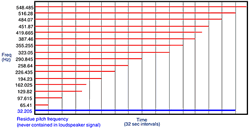

Over the course of the work, the stack of sine waves that is presented in the electronic part lessens in frequency content over time. These frequencies are gradually attenuated in the order of low to high. The notation in the score informs the performer about which equal-tempered notes to play, with cent values indicating the inflections above (+) or below (-) each pitch the cellist needs to play in order to match the frequencies of the electronic parts (Fig. 7). The performer is expected to understand these cent markings as points of unison at which no beating would be present if they were to be played on the electric cello. Consequently, the performer is asked to be adventurous with their intonation of such notes in order to explore the auditory beating that can be produced against the stack of sine waves when they play the various notes in close proximity of the cent markings presented on the score. Depending on the performance space, each performer will have their own interpretation of what level of dissonance is required to maintain a significant layer of auditory beats. This approach to the performance of Occultum Tabulatum allows the performer to enhance certain dissonances created by both monaural and binaural beating. The frequency modulations that are inherent to the vibrato (played at the performer’s discretion) correlate directly with auditory beating, which, when utilized effectively, can significantly intensify the sense of tension in this work, which is built upon restricted harmonic components.
Critical Bands (2013)
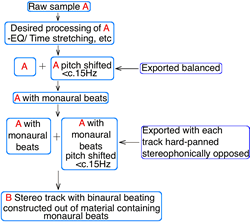
Critical Bands is an enhanced stereo (four pairs of two loudspeakers) fixed media composition that explores monaural and binaural beating as well as their potential within timbre modulation procedures. The time-scaling of material containing monaural beats is employed to create pulsating idioms, which are used to create a number of effects such as impulsive, almost “rhythmic” material.
A procedure of superimposition (in the form of a flowchart) is frequently applied in Critical Bands in order to create binaural beating using a single sample (Fig. 8). The application of this technique allowed for an internal dissonance to be created within periodic sounds. This method was also applied to a number of inharmonic sound sources, such as a cymbal and a metallic cage, which were both struck for the recording of the samples. It was found that by delicately pitch-shifting these samples and layering them over their original versions, a very thick and saturated timbre could be created that, after various equalization procedures, could add a greater depth to these sounds without noticeably altering their fundamental sonic presentation.
Audio examples 5 and 6 demonstrate the contrasting effects of monaural and binaural beating by using the same material, but with one containing certain elements positioned in the centre and the second with them hard-panned in opposite positions. In the passage beginning at 2:03 into the piece, a notch filter is used to enhance the frequencies 200 Hz and 205 Hz on a sample of processed computer noise (Audio 5). It is recommended that for such an approach a high Q factor is used, as this allows for gain to be applied to a narrower bandwidth. Both versions of the filtered sample are then hard-panned to the left and right loudspeakers, causing a 5 Hz binaural beat that results in intracranial motion. The original monaural sample exhibited a slight rumble, and this treatment using binaural beats and notch filtering enhances the intensity of that rumble while also creating a perceived movement between the loudspeakers during this climactic section (Audio 6).
Oscima (2015)
Oscima is an octophonic (enhanced stereo) fixed media work that, through a combination of binaural and monaural beating, explores the contrasting effects of the two auditory beat types. In this somewhat minimal work, a bank of noise-based resonant filters with fixed-centre frequencies is intersected by a modulating sine wave.
Over the course of the duration of the piece, a sine wave ascends from 50 Hz to 2160 Hz before then descending back to 50 Hz. An effective way of visualizing the concept explored in Oscima is to visualize an airplane (the sine wave) which constantly ascends from the ground up to a significant height before flying back towards the ground. During its journey, the airplane will fly through six different layers of clouds (resonant filters with an input of noise). In relation to the technical construction of this work, the six filters contain modulating bandwidths (50–100 Hz) with centre frequencies of 200, 500, 750, 1000, 1200 and 1600 Hz.
As the sine wave enters within approximately 15 Hz in distance from the centre frequency of each filter, beating will become apparent, thus causing a change in texture. When the sine wave is within approximately 15–30 Hz of the filters’ centre frequencies, a rough texture will be evident (Howard and Angus 2009, 84). The process of transition between smooth and rough textures and beating is a key factor in the creation of timbre in this piece. On ascent, as the sine wave approaches the proximity of an inactive filter’s maximum bandwidth, the filter is activated and remains activated until the sine wave crosses through it once more on its descent (Fig. 9).

The passing of the sine wave through the filter outputs results in binaural beating at just six of the crossover points (through the lowest three filters on ascent and descent) due to the frequency limitations of the phenomenon. Monaural beating will be evident at all other crossover points. Subtle levels of binaural beating will be heard throughout the duration of this work as, when the lower three filters continue to produce an output, minor fluctuations in their frequencies (as the noise input to the filter is not steady), combined with room reflection times and the output of the other lower three filters, result in multiple possibilities for timbral changes throughout a performance of Oscima. The output of a loudspeaker to the listener’s right-hand side may become an acoustic primary tone for binaural beating with a loudspeaker to the listener’s left as a result of the phenomenon of beating in which the two primary tones are almost mathematically related. Furthermore, reflections of a loudspeaker output from the right of the listener may be picked up by their left ear and cause binaural or monaural beating. The results of this process are dependent on the time delay from the source as well as its exact frequency output at the time of the reflection’s arrival at the opposite ear, and so forth.
A sense of perceived physical pitch height is offered in Oscima as a result of the lower three filters’ susceptibility to binaural beating, combined with the ever-ascending and descending sine wave. As the sine wave passes through the centre frequency of these filters, the intracranial motion and positioning of the beat within one’s head offers a sense of intimacy with the sonic material. Consequently, the listener should feel a greater sense of closeness with the various sound sources when the sine wave passes through the lower three crossover points, as binaural beating offers the listener a heightened level of interaction with the sound than monaural beating. By the end of the piece, it should feel as though the sine wave had embarked upon a journey of ascent before returning to the “ground level”.
In order to heighten the effects of one’s ear as an instrument, at no point in the piece are the filtered noise and sine wave emitted from the same position in the performance space when their frequency regions cross. Therefore the colouration changes are generated almost entirely within the listener’s ears in this immersive and physical work.
Conclusion
It is quite clear that for the creative applications of binaural beating in electronic music composition to be embraced within mainstream compositional culture, a greater level of dissemination of both text- and music-based output must exist. This may be achieved through practice, research output and consideration in pedagogical curricula. Furthermore, composers must accept that various boundaries may be encountered in the realization of their ideas as a result of the somewhat modest existing research output concerning theoretical material.
Binaural beating certainly has a significant level of creative scope to offer the composer and this existing lack of research output in the area strongly suggests that it has not yet been realized to any significant extent. As outlined in this paper, psychoacoustical processes resulting from the fundamental behaviour of binaural beating concerning shifts between beating and roughness, along with intracranial motion, render the phenomenon an exciting and fruitful area of consideration for music practitioners seeking to consider the ears of the listeners in a creative paradigm.
Bibliography
Akeroyd, Michael A. “A Binaural Beat Constructed from a Noise,” Journal of the Acoustical Society of America 128/6 (December 2010), pp. 3301–3304.
Bates, Enda. “The Composition and Performance of Spatial Music.” Unpublished doctoral thesis, University College Dublin, 2006.
Chechile, Alex. “Creating Spatial Depth Using Distortion Product Otoacoustic Emissions in Music Composition.” ICAD 2015 — ICAD in Space: Interactive Spatial Sonification. Proceedings of the 21st International Conference on Auditory Display (Graz, Austria: Institute of Electronic Music and Acoustics, 6 July – 10 July 2015). http://iem.kug.ac.at/icad15/icad15.html
Connolly, Brian. “The Inner Ear as a Musical Instrument.” 170th ASA Meeting. Proceedings of the 170th Meeting of the Acoustical Society of America (Jacksonville FL: Hyatt Regency Jacksonville Riverfront Hotel, 2–6 November 2015). http://scitation.aip.org/content/asa/journal/poma/25/1/10.1121/2.0000202
Fastl, Hugo and Eberhard Zwicker. Psychoacoustics: Facts and models. Berlin: Springer-Verlag, 2007.
Grose, John H., Emily Buss and William W. Hall III. “Binaural Beat Salience.” Hearing Research 285/1–2 (March 2012), pp. 40–45.
Heller, Eric J. Why You Hear What You Hear. Princeton and Oxford: Princeton University Press, 2013.
Howard, David M. and Jamie Angus. Acoustics and Psychoacoustics. Fourth edition. Oxford: Focal Press, 2009.
Kendall, Gary S. “Spatial Perception and Cognition in Multi-Channel Audio for Electroacoustic Music.” Organised Sound 15/3 (December 2010) “Sound <-> Space: New approaches to multi-channel music and audio,” pp. 228–238.
Koelsch, Stefan. Brain and Music. Oxford: Wiley Blackwell, 2013.
McFadden, Dennis and Edward Pasanen. “Binaural Beats at High Frequencies.” Science 190/4212 (October 1975) pp. 394–396.
Moore, Brian C.J. An Introduction to the Psychology of Hearing. Sixth edition. Bingley: Emerald, 2012.
Oster, Gerald. “Auditory Beats in the Brain.” Scientific American 229/4 (October 1973), pp. 94–102.
Perrott, David R. and Alan D. Musicant. “Rotating Tones and Binaural Beats.” Journal of the Acoustical Society of America 61/5 (June 1977), pp. 1288–1292.
Social top